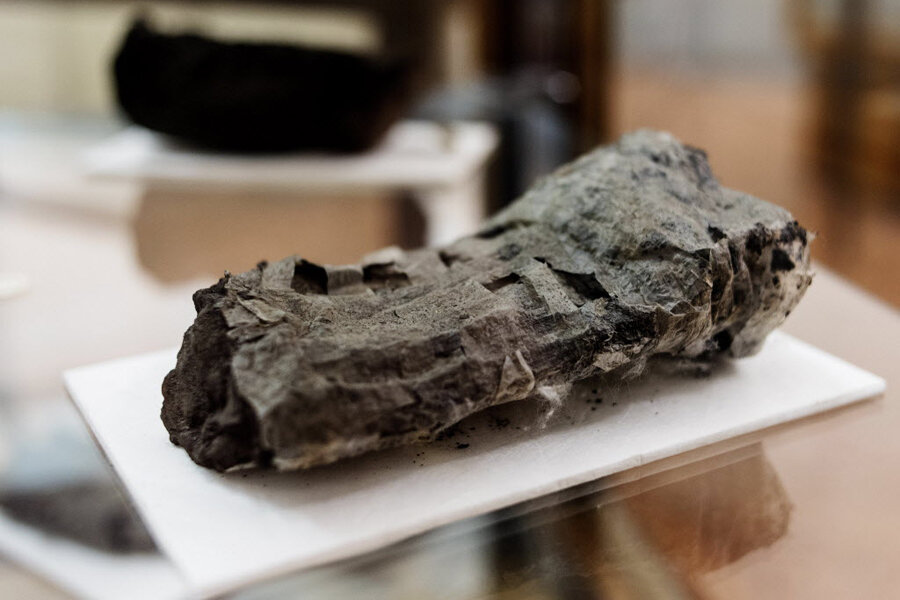Sealed shut for centuries, ancient scrolls read with X-rays
Loading...
For 2,000 years, to open a Herculaneum scroll was to destroy it.
Charred by the intense heat and pyroclastic flows of Mt. Vesuvius, whose 79 AD eruption destroyed the Roman cities of Pompeii and Herculaneum as well as several nearby settlements, the papyrus scrolls remained buried under ash until 1752, when they were discovered in Herculaneum in a private residence that housed an impressive library – later dubbed the “Villa of the Papyri.”
Rather than incinerating these scrolls, the volcanic blast carbonized the papyrus and rendered the scrolls charred cylinders – thus locking in, but preserving their contents. Over 1,800 scrolls have been excavated from the site since their discovery – but most attempts at unrolling them have resulted in the destruction of the scrolls themselves.
But researchers have found a new way to safely read these ancient parchments, without ever opening them, according to new study published in Nature Communications.
“I was in Grenoble for a collaboration, and they explained to me some new developments using phase contrast for science, for paleontology.... They sounded like exotic applications,” study author Vito Mocella told BBC News. “And I said, I have another idea.”
Dr. Mocella, of the Institute for Microelectronics and Microsystems in Naples, was able to create digital images of the documents using X-ray technology. Similar techniques had been utilized before, but with little success. This is because the ancient ink used on the Herculaneum scrolls was likely made with soot – which is mostly carbon. The papyri themselves were carbonized by the volcanic eruption, meaning that conventional X-rays cannot distinguish between the paper and the ink.
So Mocella’s team used a process called X-ray phase-contact tomography. Because the Herculaneum scrolls weren’t fully absorptive, the ink rested on the surface, leaving slightly raised (just one tenth of a millimeter) grooves in the shape of letters. X-rays hitting a raised surface would reflect back with a shifted phase. Using these phase differences, the team generated 3D images of the pages.
“This attempt opens up new opportunities to read many Herculaneum papyri, which are still rolled up, thus enhancing our knowledge of ancient Greek literature and philosophy,” Mocella said.
The technique is far from perfect, Mocella says. Letters with straight horizontal or vertical lines can be lost among the woven grids of papyrus – curved letters are easier to read. And the imaging process, which is painstaking and time-consuming, still involves a lot of guesswork. Moreover, many scrolls were crushed as well as charred – adding to the implicit difficulty of reading them. So far, the team has only been able to analyze a handful of the many unread papyri.
Based on previous, albeit damaging unravelings, historians suggest that the majority of the scrolls contain writings by philosophers Epicurus and Philodemus. Epicurean philosophy posits that one can achieve true happiness by pursuing tranquility and ridding oneself of pain.
“Most of what we know of Epicureanism is from these papyri,” Mocella told LiveScience.
So far, archaeologists have only unearthed Greek-language scrolls at the Villa of Papyri. But most ancient Roman libraries contained both Greek and Roman works in separate collections, so there’s a glimmer of hope for the future discovery of Roman texts at the Villa. And those documents, likewise blackened by volcanic activity, could also be read by way of X-ray phase-contrast tomography.
“It would have been odd for a villa of this sort not to have had a major library,” Richard Janko, who translated a number of the scrolls, told the New York Times. “So this technology, when perfected, does open the way to rediscovering a lot more ancient literature.”
Jennifer Sheridan Moss, a papyrologist at Detroit’s Wayne State University and the president of the American Society of Papyrologists, says this method could also be used to read other delicate ancient documents – not just charred scrolls.
“We could easily find more things that are in bad shape like this, and then the technology could be applied to them,” Moss told LiveScience.
Mocella says that, while this research has philosophical and literary value regarding the scrolls themselves, the technology has the potential “to be applied to completely new fields.”








